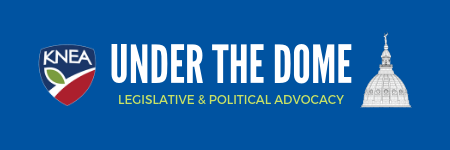 Dyslexia Task Force Bill Passes Senate Committee
Dyslexia Task Force Bill Passes Senate Committee
The Senate Education Committee met today to work two bills. The first was Sub for HB 2602 which establishes a Dyslexia Task Force to consider how best to identify and serve students with dyslexia.
Three amendments to the bill were adopted.
The first amendment by Sen. Barbara Bollier (R-Mission Hills) would add the words “and other reading comprehension impairments” throughout the bill to be sure that the Task Force explores identification and support for all reading disabilities.
The second amendment by Sen. Pat Pettey (D-Kansas City) would ensure that the task force had access to the services of the legislative research department.
The third and final amendment by Sen. Molly Baumgardner (R-Louisburg) changed the composition of the task force by eliminating four legislators and adding teachers. Under the amendment, the task force will now be composed of 17 voting members as follows:
- one member of the Senate
- one member of the House
- one member of the SBOE who shall serve as Chair
- one professor employed by a state educational institution,
- two principals,
- four parents of children diagnosed with dyslexia,
- one special education director
- one elementary building-level reading specialist,
- one elementary special education teacher,
- one elementary classroom teacher,
- one middle school classroom teacher,
- one licensed psychologist or speech-language pathologist who diagnoses dyslexia, and
- one appointee of the Disability Rights Center of Kansas.
There will also be two non-voting attorneys on the task force; one from the State Department of Education and one who is familiar with dyslexia issues.
The amendment also spells out how such members will be appointed.
All three amendments passed unanimously and the bill, as amended, was passed out of committee unanimously. It now goes to the full Senate for consideration.
Education Inspector General Bill Defeated in Committee
Senate Bill 424 which would have established an “Education Inspector General” in the State Treasurer’s Office was also worked in the Senate Education Committee today. This position appeared to be created in response to the anger conservatives felt over the distribution of school transportation funding which erupted earlier in the session.
The position was intended to run continuing audits of school districts with the intent to find inefficiencies and fraud. While some amendments were offered and some of those amendments were adopted, in the end, a motion to pass the bill out of committee as amended failed on a vote of 5 to 6. The bill will not go forward.
Senate Finance Committee Hears Transportation Bills
So the Education Inspector General bill was defeated but transportation continued to be a topic immediately afterward when the Senate Select Committee on School Finance met to hold hearings on two bills dealing with transportation.
The first bill, SB 352, would move the funding for school transportation from the Highway Department to the State General Fund. For years transportation funding has been transferred out the Highway Fund. This bill would simply change the source of those funds to the State General Fund and would have no impact on the formula.
The second bill, SB 450, was introduced by Sen. Bollier and would put into law the curve of best fit in the transportation formula. The curve adjustment has been used for many years but when it was revealed this year that it was not actually in statute there was an uproar among conservatives. The Legislative Post Audit had recommended that it be put in statute.
There have been several bills to do this but the Bollier proposal is the first to adjust the formula such that it can be adjusted easily if more transportation funding is needed and to respond automatically to rising costs.
No action was taken on either bill today.
Commissioner Watson Back in K-12 Budget Committee
Education Commissioner Randy Watson made a return appearance before the House K-12 Budget Committee today to once again review Kansans Can! and share the accreditation program the department uses.
The presentation was not terribly long today (they’ve had presentations like this before this session) and did not generate a lot of discussions.
Watson also demonstrated the use of the School Report Cards website and how it can allow policy-makers, parents, and school personnel to keep up with performance indicators and even find like school districts with whom to potentially partner for professional development.


